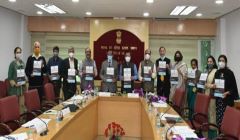The main objective of successive rounds of the NFHS is to provide reliable and comparable data relating to health and family welfare and other emerging issues

Dr. Vinod Kumar Paul, Member (Health), NITI Aayog and Rajesh Bhushan,Secretary, Union Ministry of Health and FamilyWelfare, Government of India, released the Factsheets of key indicators on population, reproductive and child health, family welfare, nutrition and others forIndia and 14 States/UTs (clubbed under Phase-II) of the 2019-21 National Family Health Survey (NFHS-5).
The key results from India and Phase-II States/UTs NFHS-5 Factsheets areas below:
The Total Fertility Rates (TFR), an average number of children per women has further declined from 2.2 to 2.0 at the national level and all 14States/UT’s ranging from 1.4 in Chandigarh to 2.4 in Uttar Pradesh. All Phase-II states have achieved replacement level of fertility (2.1) except Madhya Pradesh, Rajasthan, Jharkhand and Uttar Pradesh.
Overall Contraceptive Prevalence Rate (CPR) has increased substantially from 54% to 67% at all-India level and in almost all Phase-II States/UTs with an exception of Punjab. Use of modern methods of contraceptives has also increased in almost all States/UTs.
Unmet needs of family planning have witnessed a significant decline from 13 per cent to 9 per cent at all-India level and in most of the Phase-II States/UTs. The unmet need for spacing which remained a major issue in India in the past has come down to less than 10 per cent in all the States except Jharkhand (12%), Arunachal Pradesh (13%) and Uttar Pradesh (13%).
Full immunization drive among children aged 12-23 months has recorded substantial improvement from 62 per cent to 76 per cent at all-India level. 11 out of 14 States/UTs has more than three-fourth of children aged 12-23 months with fully immunization and it is highest (90%) for Odisha.
On comparing NFHS-4 and NFHS-5 data, the increase in full immunization coverage is observed to be expeditious in many states and UTs; More than50 per cent of Phase-II States/ UTs are sharing over 10 percentage points during the short span of 4 years. This can be attributed to the flagship initiative of Mission Indradhanush launched by the government since 2015.
There is an increase from 51 per cent to 58 per cent of women receiving four or more ANC visits by health providers at all-India level.
Also, all the Phase-II States/UTs have shown improvement except Punjab between 2015-16 to2019-20.
Institutional births have increased substantially from 79 per cent to 89 percent at all-India Level. Institutional delivery is 100 per cent in Puducherry and Tamil Nadu and more than 90 per cent in 7 States/UTs out of 12 Phase II States/UTs.
Along with an increase in institutional births, there has also been a substantial increase in C-section deliveries in many States/UTs especially in private health facilities.
Child Nutrition indicators shows a slight improvement at all-India level as Stunting has declined from 38 per cent to 36 per cent, wasting from 21 per cent to 19 per cent and underweight from 36 per cent to 32 percent at all India level. In all phase-II States/UTs situation has improved in respect of child nutrition but the change is not significant as drastic changes in respect of these indicators are unlikely in short span period.
Anaemia among children and women continues to be a cause of concern. More than half of the children and women (including pregnant women) are anemic in all the phase-II States/UTs and all-India level compared to NFHS4, in spite of substantial increase in the composition of iron folic acid (IFA)tablets by pregnant women for 180 days or more.
Exclusive breastfeeding to children under age 6 months has shown an improvement in all-India level from 55 percent in 2015-16 to 64 per cent in 2019-21. All the phase-II States/UTs are also showing a considerable progress.
Women's empowerment indicators portray considerable improvement at all India level and across all the phase-II States/UTs. Significant progress has been recorded between NFHS-4 and NFHS-5 in regard to women operating bank accounts from 53 percent to 79 percent at all-India level. For instance, in the case of Madhya Pradesh the increase was to the tune of 37 percentage point from 37 per cent to 75 per cent. More than 70 per cent of women in every state and UTs in the second phase have operational bank accounts.
The States and UTs which were surveyed in the Phase-II are Arunachal Pradesh, Chandigarh, Chhattisgarh, Haryana, Jharkhand, Madhya Pradesh, NCT of Delhi, Odisha, Puducherry, Punjab, Rajasthan, Tamil Nadu, Uttar Pradesh and Uttarakhand. The findings of NFHS-5 in respect of 22 States & UTs covered in Phase-I were released in December, 2020

Subscribe To Our Newsletter & Stay Updated